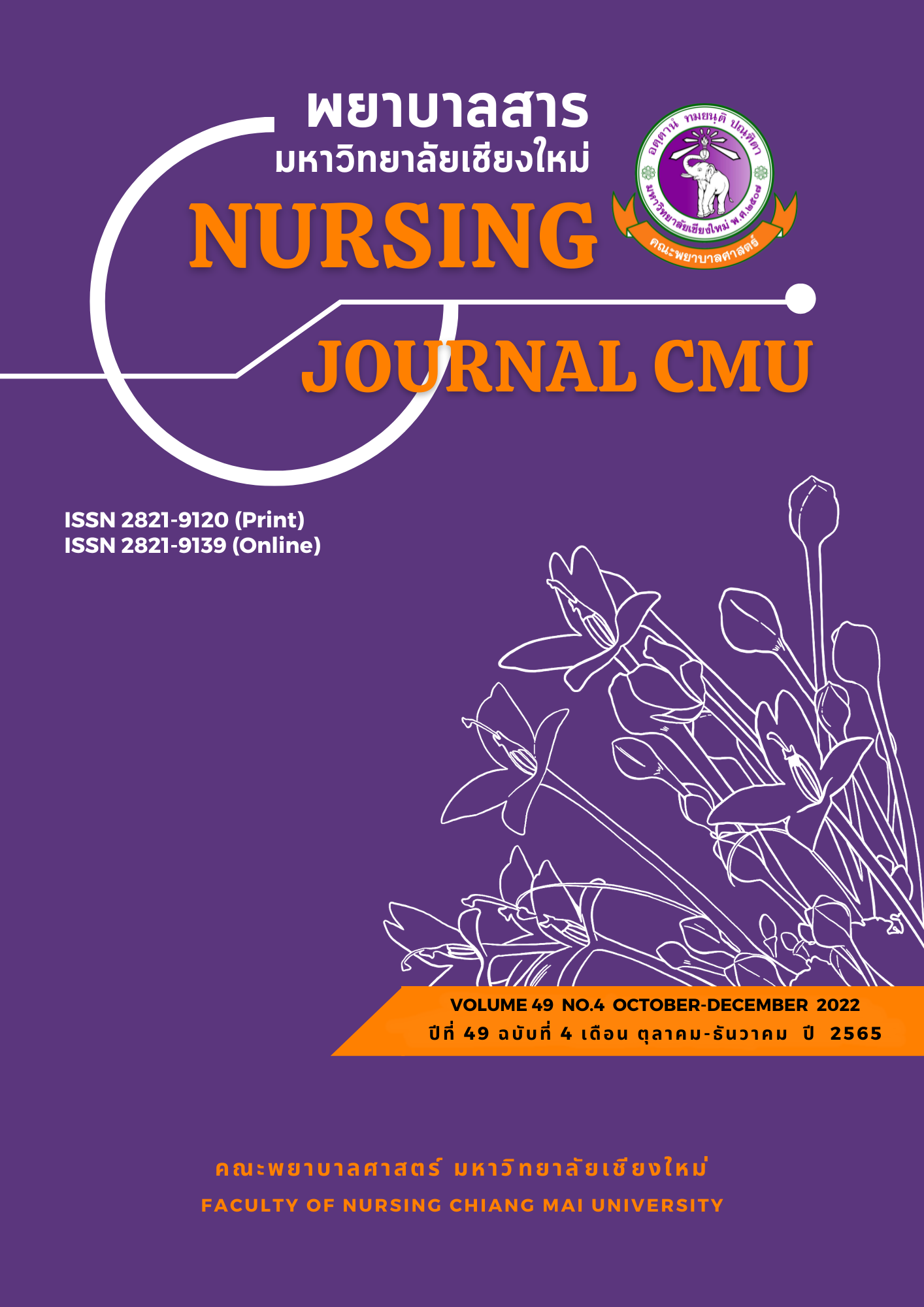Self-care practice Among Adolescent Primigravida in Northern Thailand: A Mixed Method Study
Keywords:
Self-care, Primigravida teenagers, Mixed method studyAbstract
This mixed method study aimed to describe self-care practice and conditioning factors in self-care among primigravida teenagers in Northern Thailand and was divided into two phases. In the first phase, a quantitative study aimed to explore self-care practice among primigravida teenagers. Stratified random sampling was used to recruit 216 primigravida teenagers as informants, and data were collected using self-administered questionnaires. In the second phase, a qualitative study aimed to explore the conditioning factors affecting self-care practice; 30 primigravida teenagers were interviewed in-depth. The quantitative data were analyzed using quantitative statistics, and the qualitative data were analyzed using content analysis.
The results of this study revealed that 21.80%, 66.20%, and 12.00% of primigravida teenagers demonstrated a high level, moderate level, and low level of self-care practice, respectively (Max = 113, Min = 64, Mean = 93.14, SD = 7.62). The conditioning factors related to self-care practice among primigravida teenagers could be classified into six themes: 1) mother-baby bonding, 2) ready for pregnancy, 3) family support, 4) economic problems, 5) knowledge and awareness about self-care practice for herself and her infant, and 6) smoking contact.
The findings of this study can be used as basic information for nurses and health personnel to promote adolescent pregnant women to practice appropriate self-care in order to have a healthy mother and baby.
References
Chiang Rai Provincial Health Office. (2018). Information system for promotion and prevention In Maternal and Child Health reports. Retrieved from http://cro.moph.go.th/moph/index.php. (in Thai)
Cresswell, J.W., Fetters, M.D. & Ivankova, N.V. (2004). Designing a mixed methods study in primary care. The Annals of Family Medicine, (2), 7-12.
Department of health. (2017). Teenage pregnancy surveillance report. Reproductive health office, Department of health. (in Thai)
Elo, S. & Kyngas, H. (2008). The Qualitative content analysis process. Journal of Advanced Nursing, 62 (1), 107-115.
Hermandez, N. D. (2013). An exploration of the meaning and consequences of unintended
pregnancy among Latin cultural subgroups: Social, cultural, structural, historical and political influences. (Doctoral dissertation, Philosophy in community and family health college of public health), University of south Florida.
House, J. S. & Kahn, R. (1985). Measure and concepts of social support. In Cohen, S. & Syme, S. L.(Eds.), Social support and health. New York: Academic Press.
Intarangkul Na Ayutaya, A. (2017). Health promotion in pregnant women. In Chalearnsarnti, J. (Ed.). Nursing and midwifery: Pregnancy women. Chiangmai: Siamprimnana. (in Thai)
Karalai, S. & Sriratanaprapat, J. (2018). Relationships between social support and health promoting behavior among pregnant teenagers. The Journal of Faculty of Nursing,Burapha University, 26(1), 1-10. (in Thai)
Lertsacornsiri, M. (2015). Nursing care of pregnancy women during ante-natal care and during labor. Bangkok: Assumption. (in Thai)
Meleis, A. I., Sawyer, L. M., Im, E. O., Messias, D. K. H., & Shumacher, K. L. (2000).
Experiencing transitions: An emerging middle-range theory. Advances in Nursing Science, 23(1), 12-28.
Mercer, R. T. (1985). The process of maternal role attainment over the first year. Nursing Research, 34(4), 198-204.
Naphapunsakul, M., Prateepchaikul, L., Taboonpong, S., & Punthmatharith, B. (2007). Factors influencing maternal role performance in transition to being the first-time mother. Songklanagarind Medical Journal, 25(1), 1-8. (in Thai)
Natitanasombat, K. (2012). Transition Theory: A case study of a normal pregnant woman. Huachiew Chalermprakiet University Journal, 16(31), 103-116. (in Thai)
Nawarat, S., Fongsuwan, W., & Pungnirun, B. (2013). A structural equation model development of variables that effect to depression among pregnancy of Thai adolescent. Journal of the Association of Researcher, 18(2), 99-112. (in Thai)
Orem, D.E. (2010). Nursing concepts of practice (6thed.). London: St Louise, Missouri: Mosby.
Ouiyanukoon, P. & Kalayasiri, R. (2017). Prevalence and related factors of pregnant women received second hand smoke during pregnancy. Chulalongkorn Medical Journal, 60(6), 689–698. (in Thai)
Polit, D. F. (2010). Statistics and data analysis for nursing research (2nded.). Boston, MA: Pearson.
Pitakwachara(Yamapai), N., (2517). Ante-natal care. In Wanitchapongpun, P., Rassamichareaun, K., & Lertbunapong, T. (Eds.). Modern textbook of obstetrics (1sted., pp. 64-76). Bangkok: P. A. living. (in Thai)
Rongluen, S, Talengjit, P., & Siriborirak, S. (2012). Unwanted pregnancies in teenagers: A survey of problems and needs for health care support. Siriraj Nursing Journal, 3(2), 14-28. (in Thai)
Thipjun, B. & Kaewpan, W. (2017). Factors related to self-care behaviors of teenage pregnant
women in Phetchaburi province. Journal of the Office of Disease Prevention and Control Region 7, 11(1), 41-60. (in Thai)
Tongmuangtunyatep, K., Pongchangyou, K, Malai, C., & Busayapranpong, H. (2019). Effects of
cigarette smoke in pregnant women on fetus: A Systematic review. Journal of Nursing and Education, 12(1), 117-132. (in Thai)
Wise, N. J. (2015). Pregnant adolescents, beliefs about healthy eating, factors that
Influence food choices, and nutrition education preferences. Journal of Midwifery & woman’s Health, 60(4), 410-418.
World health statistic. Monitoring health for the sustainable development goals. (2019). Retrieved from https://apps.who.int/iris/bitstream/handle/10665/324835/9789241565707-eng.pdf
Downloads
Published
How to Cite
Issue
Section
License
Copyright (c) 2022 Nursing Journal

This work is licensed under a Creative Commons Attribution-NonCommercial-NoDerivatives 4.0 International License.
บทความที่ได้รับการตีพิมพ์เป็นลิขสิทธิ์ของวารสารพยาบาลสาร
ข้อความที่ปรากฏในบทความแต่ละเรื่องในวารสารวิชาการเล่มนี้เป็นความคิดเห็นส่วนตัวของผู้เขียนแต่ละท่านไม่เกี่ยวข้องกับมหาวิทยาลัยเชียงใหม่ และคณาจารย์ท่านอื่นๆในมหาวิทยาลัยฯ แต่อย่างใด ความรับผิดชอบองค์ประกอบทั้งหมดของบทความแต่ละเรื่องเป็นของผู้เขียนแต่ละท่าน หากมีความผิดพลาดใด ๆ ผู้เขียนแต่ละท่านจะรับผิดชอบบทความของตนเองแต่ผู้เดียว






